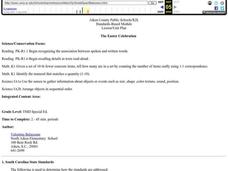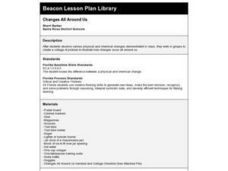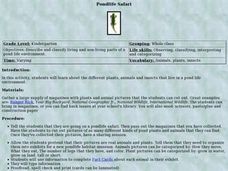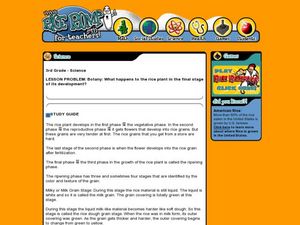Curated OER
Natural Resources and Your Christmas Tree
In this natural resources and your Christmas tree worksheet, students read about the raw materials used to make items associated with Christmas trees, match 12 items with materials, then color a picture.
Curated OER
Parts of Art
Young scholars define and use new vocabulary associated with the elements of art. As a class, they brainstorm different ways in which we communicate with one another. In groups, they view different pieces of art from the Native American...
Curated OER
Emotions for ESL Students
You might get emotional during this activity - but don't worry, that's the idea! The class practices analyzing emotions, including their own, their peers' facial expressions, and colors and sounds that remind them of certain emotions....
Curated OER
Lesson 2: Draw a Fire-Safety Picture
Students illustrate fire safety practices. In this early childhood lesson plan, students identify fire hazards within the home, and discuss fire safety. Students read mini-books based on fire safety, and then illustrate fire safety...
Curated OER
Collecting My School Family Data
Pupils are tasked with collecting data on their school. In groups, they collect data on various aspects of school life along with social and economic backgrounds and charactertics of their hair and eye color. They draw two pictures,...
Curated OER
Rocks and Minerals
Students research a rock or mineral on the Internet. They perform the research with a partner to find out properties such as, color, hardness, and opacity. They look for pictures on the Internet in order to prepare for their slideshow...
Curated OER
The Easter Celebration
Students read a short story about Easter. They recognize and point to pictures of the key words (egg, chicken, rabbit, basket, flower). They make an Easter basket and count how many chickens can fit inside. They also practice identifying...
Curated OER
Changes All Around Us
Sixth graders, in groups, observe the difference between physical and chemical changes and create a collage of pictures to show the difference.
Curated OER
Classification and Identification
Young scholars, after exploring and analyzing diagrammatic and taxonomic keys and their association to marine sciences, identify and classify objects and organisms based on visual attributes/characteristics. They research and create...
Curated OER
Health Education: Childhood Diseases and Health Issues
Fourth graders research childhood diseases and health conditions. In this personal health lesson plan, 4th graders identify problems associated with and measures to control common childhood diseases or conditions such as asthma,...
Curated OER
Pond-life Safari
Students determine the living and non-living parts of pond life. In this pond life lesson, students examine the plants, animals, and insects that live in ponds. They look through a variety of print media, cut out pictures, and arrange...
Curated OER
What is a Hero? Heroism in Greek Mythology
Students explore the tales of Greek mythology and discuss what it means to be a hero. They associate acts of epic heroism with philanthropy noting that these characters acted in a larger than life manner to secure the common good.
Curated OER
The Earthworm
In this science related worksheet, students complete a wide variety of interactive activities associated with earthworms and their inhabitants.
Curated OER
Patty the Pretty Pig
Students recognize the phoneme /p/. Through listening, writing, and matching activities, students discriminate the phoneme /p/ from similar looking letters and phonemes. They associate the phoneme /p/ with its letter representation and...
Curated OER
A Cat Nap
First graders recognize the short vowel A in written and spoken language. Through matching activities, they discriminate the short vowel /a/ from other phonemes. Students associate the phoneme with its letter representation and read...
Curated OER
Seeing Cells
Sixth graders study living cells and their functioning units. In this cell lesson students color cell diagrams, answer questions and discuss the differences between plant and animal cells.
Knox Education
Opinion Argument Writing Packet
You won't need much persuading to use an argumentative writing packet in your language arts class! With helpful reference pages, guided practice through the writing process, examples of opinion and argument writing, and a thorough...
Curated OER
Adam, Abby, and the Stolen Apple
Pupils recognize the short vowel a in written and spoken language. Through matching activities, they discriminate the short vowel /a/ from other vowel phonemes. Students associate the phoneme with its letter representation and identify...
Teaching Tolerance
The Power of Words: Ethnic Stereotypes
Pupils study stereotypes that are associated with different ethniciites or regional groups. They examine how occupations can be hypothetically related to ethnic sounding names.
Curated OER
Collage of Kwanzaa Colors
Students explore African cultures by creating a holiday collage. In this Kwanzaa art lesson plan, students identify the popular colors associated with the African holiday and create a collage using them. Students present their art work...
Curated OER
Poetry: Serve Warmly and More Often
Pupils identify the mood and theme associated with the language of poetry. They discuss personal interpretation in small groups, and as a class and * experiment with language and rhythm.
Curated OER
Botany: Rice Plant Development
Learners determine what occurs in the final stages of the development of a rice plant. In this rice plant development lesson, students use the associated study guide to list the three stages in the ripening phase of rice development....
Curated OER
Prince Hall and His Organization of Black Free Masons in the United States
Students examine the life of Prince Hall who became a member of the Free Masons during the time period of slavery. Depending on the grade level, they are shown pictures or read a reference guide listing the characteristics of each...
Curated OER
La comida
Students practice new vocabulary associated with basic food items. Using directions, they combine food items. They listen to a native Spanish speaker using the Qsteps program. Using the program, they interact with it by answering...

























